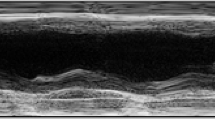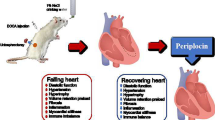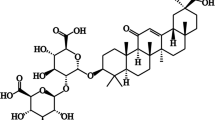Summary
Ranolazine, a late sodium current inhibitor, has been demonstrated to be effective on heart failure. 18β-glycyrrhetinic acid (18β-GA) has the similar inhibitory effect on late sodium currents. However, its effect on diastolic function is still unknown. This study aimed to determine whether 18β-GA can improve the diastolic function and to explore the underlying mechanisms. Eighty male Sprague Dawley (SD) rats of Langendorff model were randomly divided into the following groups: group A, normal cardiac perfusion group; group B, ischemia-reperfusion group; group C, ischemia-reperfusion with anemoniasulcata toxin II (ATX-II); group D, ranolazine group; and group E, 18β-GA group with four different concentrations. Furthermore, a pressure-overloaded rat model induced by trans-aortic constriction (TAC) was established. Echocardiography and hemodynamics were used to evaluate diastolic function at 14th day after TAC. Changes of free intracellular calcium (Ca2+) concentration was indirectly detected by laser scanning confocal microscope to confirm the inhibition of late sodium currents. With the intervention of ATX-II on ischemia reperfusion injury group, 5 µmol/L ranolazine, and 5, 10, 20, 40 µmol/L 18β-GA could improve ATX-II-induced cardiac diastolic dysfunction. 630 mg/kg glycyrrhizin tablets could improve cardiac diastolic function in the pressure-overloaded rats. 18β-GA and ranolazine had similar effects on reducing the free calcium in cardiomyocytes. The study demonstrates that 18β-GA and glycyrrhizin could improve diastolic dysfunction induced by ischemia-reperfusion injury in Langendorff-perfused rat hearts and pressure-overloaded rats. The mechanism may be attributed to the inhibition of enhanced late sodium currents.
Similar content being viewed by others
References
Hasenfuss G, Schillinger W, Lehnart SE, et al. Relationship between Na+-Ca2+-exchanger protein levels and diastolic function of failing human myocardium. Circulation, 1999,99:641–648
Belardinellia L, Antzelevitch C, Fraserc H. Inhibition of late (sustained/persistent) sodium current: a potential drug target to reduce intracellular sodium-dependent calcium overload and its detrimental effects on cardiomyocyte function. Eur Heart J Suppl, 2004,6(suppl I):13–17
Noble D, Noble PJ. Late sodium current in the pathophysiology of cardiovascular disease: consequences of sodium-calcium overload. Heart, 2006,92(Suppl 4):iv1–iv5
Hale SL, Shryock JC, Belardinelli L, et al. Late sodium current inhibition as a new cardioprotective approach. J Mol Cell Cardiol, 2008,44(6):954–967
Undrovinas NA, Maltsev VA, Belardinelli L, et al. Late sodium current contributes to diastolic cell Ca2+ accumulation in chronic heart failure. J Physiol Sci, 2010,60(4):245–257
Conti CR. Ion channel therapy of ischemic heart disease: from calcium channel blockers to late sodium current inhibition. Clin Cardiol, 2011,34(2):66–67
Pourrier M, Williams S, McAfee D, et al. Cross Talk proposal: The late sodium current is an important player in the development of diastolic heart failure (heart failure with a preserved ejection fraction). J Physiol, 2014,592(3):411–414
El-Saber BG, Magdy BA, El-Mleeh A, et al. Traditional Uses, Bioactive Chemical Constituents, and Pharmacological and Toxicological Activities of Glycyrrhiza glabra L. (Fabaceae). Biomolecules, 2020,10(3):352
Pastorino G, Cornara L, Soares S, et al. Liquorice (Glycyrrhiza glabra): A phytochemical and pharmacological review. Phytother Res, 2018,32(12):2323–2339
Miura T, Ohnuma Y, Kuno A, et al. Protective role of gap junctions in preconditioning against myocardial infarction. Am J Physiol Heart Circ Physiol, 2004,286(1):214–221
Su DC, Chang ZW, Fan SY. Role of gap junction in ischemic preconditioning. Zhonghua Xin Xue Guan Bing Za Zhi (Chinese), 2006,34(8):690–694
Sossalla S, Wagner S, Rasenack EC, et al. Ranolazine improves diastolic dysfunction in isolated myocardium from failing human hearts—role of late sodium current and intracellular ion accumulation. J Mol Cell Cardiol, 2008,45(1):32–43
Williams S, Pourrier M, McAfee D, et al. Ranolazine improves diastolic function in spontaneously hypertensive rats. Am J Physiol Heart Circ Physiol, 2014,306(6):H867–881
Hwang H, Arcidi JM Jr, Hale SL, et al. Ranolazine as a cardioplegia additive improves recovery of diastolic function in isolated rat hearts. Circulation, 2009,120(11 Suppl):S16–21
Coppini R, Ferrantini C, Yao L, et al. Late sodium current inhibition reverses electromechanical dysfunction in human hypertrophic cardiomyopathy. Circulation, 2013,127(5):575–584
Du YM, Zhang S, Wu H, et al. Glycyrrhetinic acid blocks cardiac sodium channels expressed in Xenopus oocytes. J Ethnopharmacol, 2009,125(2):318–323
Bell RM, Mocanu MM, Yellon DM. Retrograde heart perfusion: the Langendorff technique of isolated heart perfusion. J Mol Cell Cardiol, 2011,50(6):940–950
Jayasooriya RG, Dilshara MG, Park SR, et al. 18β-Glycyrrhetinic acid suppresses TNF-α induced matrix metalloproteinase-9 and vascular endothelial growth factor by suppressing the Akt-dependent NF-κB pathway. Toxicol In Vitro, 2014,28(5):751–758
Xiao Y, Xu J, Mao C, et al. 18β-glycyrrhetinic acid ameliorates acute Propionibacterium acnes-induced liver injury through inhibition of macrophage inflammatory protein-1alpha. J Biol Chem, 2010,285(2):1128–1137
Huang M, Xie X, Gong P, et al. A 18β-glycyrrhetinic acid conjugate with Vorinostat degrades HDAC3 and HDAC6 with improved antitumor effects. Eur J Med Chem, 2020,188:111 991
Zhang P, Chang Z, Yang J, et al. Vasorelaxation effect of 18β-glycyrrhetinic acid on the thoracic aorta of rats: proposed mechanism. Pharmazie, 2019,74(12):751–754
Tamir S, EM, Somjen D, et al. Estrogen-like activity of glabrene and other constituents isolated from licorice root. J Steroid Biochem Mol Biol, 2001,78(3):291–298
Somjen D, Knoll E, Vaya J, et al. Estrogen-like activity of licorice root constituents: glabridin and glabrene, in vascular tissues in vitro and in vivo. J Steroid Biochem Mol Biol, 2004,91(3):147–155
Chung TH, Wang SM, Chang YC, et al. 18β-glycyrrhetinic acid promotes src interaction with connexin43 in rat cardiomyocytes. J Cell Biochem, 2007,100(3):653–664
Zaza A, Belardinelli L, Shryock JC. Pathophysiology and pharmacology of the cardiac “late sodium current”. Pharmacol Ther, 2008,119(3):326–339
Parisella ML, Angelone T, Gattuso A, et al. Glycyrrhizin and glycyrrhetinic acid directly modulate rat cardiac performance. J NutrBiochem, 2012,23(1):69–75
Zhang Y, Yu L, Jin W, et al. Reducing toxicity and increasing efficiency: aconitine with liquiritin and glycyrrherinic acid regulate calcium regulatory proteins in rat myocardial cell. Afr J Tradit Complement Altern Med, 2017,14(4):69–79
Wang L, He Y, Zhang Y, et al. Effects of Active Components of Fuzi and Gancao Compatibility on Bax, Bcl-2, and Caspase-3 in Chronic Heart Failure Rats. Evid Based Complement Alternat Med, 2016,2016:7686045
Ojha SK, Sharma C, Golechha MJ, et al. Licorice treatment prevents oxidative stress, restores cardiac function, and salvages myocardium in rat model of myocardial injury. Toxicol Ind Health, 2015,31(2):140–152
Zhang M, Wang C, Cai HL, et al. Licorice Extracts Attenuate Nephrotoxicity Induced by Brucine through Suppression of Mitochondria Apoptotic Pathway and STAT3 Activation. Curr Med Sci, 2019,39(6):890–898
Jeong EM, Dudley SC Jr. Diastolic Dysfunction: Potential New Diagnostics and Therapies. Circ J, 2015,79(3):470–477
Ojha S, Golechha M, Kumari S, et al. Glycyrrhiza glabra protects from myocardial ischemia-reperfusion injury by improving hemodynamic, biochemical, histopathological and ventricular function. Exp Toxicol Pathol, 2013,65(1–2):219–227
Zhang XQ, Yamada S, Barry WH. Ranolazine inhibits an oxidative stress-induced increase in myocyte sodium and calcium loading during simulated-demand ischemia. J Cardiovasc Pharmacol, 2008,51:443–449
Du YM, Xia CK. 18β-Glycyrrhetinic acid preferentially blocks late Na current generated by ΔKPQ Nav1.5 channels. Acta Pharmacologica Sinica, 2012,33:752–760
Åsmund TR, Michael F, William EL. Targeting Cardiomyocyte Ca2+ Homeostasis in Heart Failure. Curr Pharm Des, 2015,21(4):431–448
Author information
Authors and Affiliations
Corresponding author
Ethics declarations
The authors have declared that no conflicts of interest exists.
Additional information
This project was supported by the National Natural Science Foundation of China (No. 81600317 and No. 81700345) and the Open Foundation of Hubei Key Laboratory of Biological Targeted Therapy (No. 02.03.2014-10).
Rights and permissions
About this article
Cite this article
Han, J., Su, Gh., Wang, Yh. et al. 18β-Glycyrrhetinic Acid Improves Cardiac Diastolic Function by Attenuating Intracellular Calcium Overload. CURR MED SCI 40, 654–661 (2020). https://doi.org/10.1007/s11596-020-2232-y
Received:
Accepted:
Published:
Issue Date:
DOI: https://doi.org/10.1007/s11596-020-2232-y




